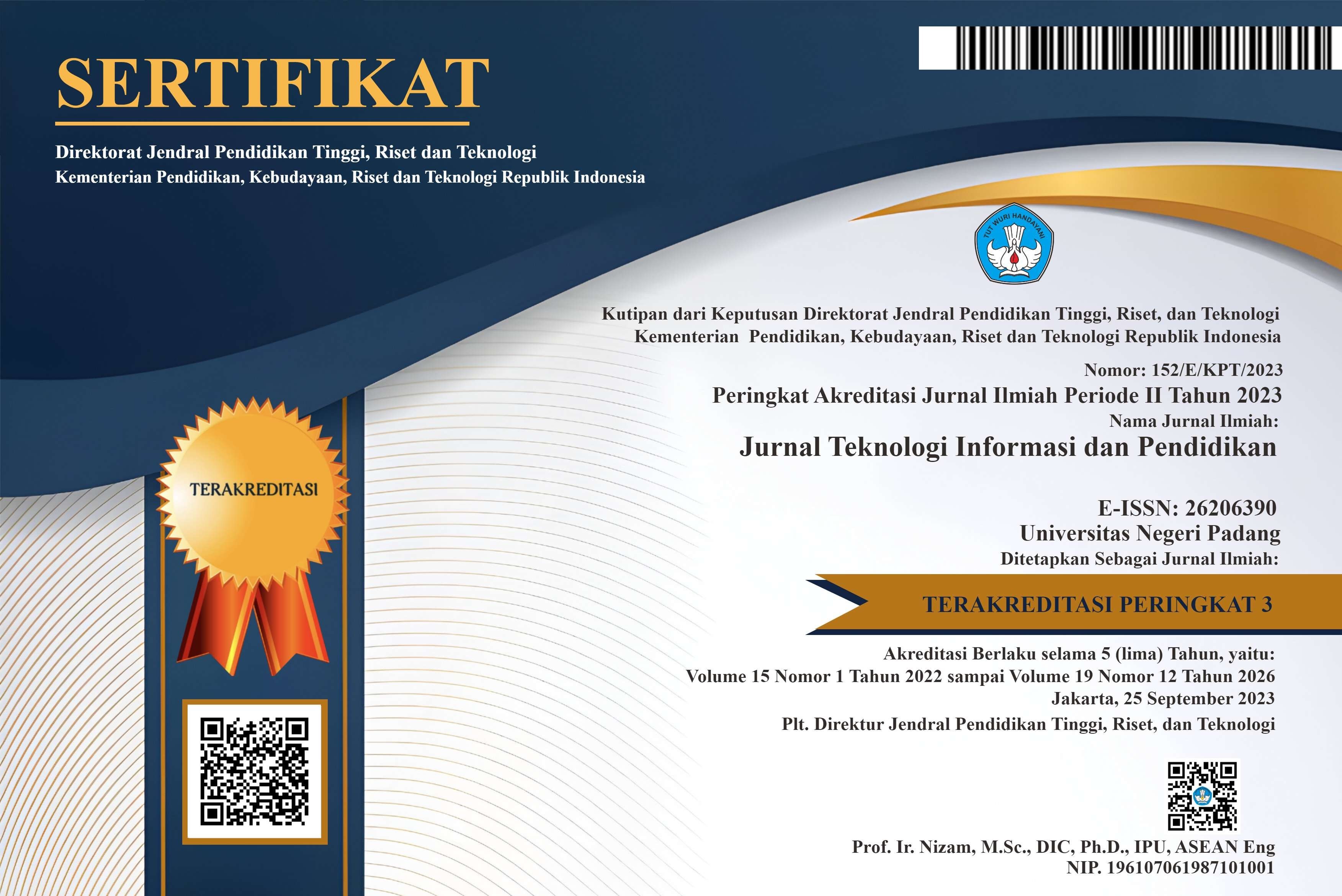AUGMENTED REALITY SEBAGAI MEDIA PEMBELAJARAN INOVATIF DI ERA REVOLUSI INDUSTRI 4.0
DOI:
https://doi.org/10.24036/tip.v12i2.244Keywords:
Augmented Reality, Vuforia, Unity 3D, Instructional MediaAbstract
The main purpose of this paper is to uncover the results of a survey study regarding teacher opinions on the use of Augmented Reality (AR) in learning. For this purpose, marker-based cellular augmented reality applications have been developed and computer hardware is used as training material. In addition, teachers are given training for four days to get to know the basics of augmented reality technology, the software used, the environment to create marker-based AR objects. The data was collected through surveys and open-ended questions on teachers who are members of the English MGMP Kab. 50 cities. The tools and technology needed to develop AR and development experience are also shared. According to the survey results teachers are very enthusiastic about using augmented reality in their learning. The result of this article is the perception of the use of Augmented Reality technology for the development of instructional media by English teachers in the positive category.
References
Y. Hendriyani, N. Jalinus, V. I. Delianti, and L. Mursyida, “Analisis Kebutuhan Pengembangan Media Pembelajaran Berbasis Video Tutorial,” J. Teknol. Inf. Pendidik., vol. 11, no. 2, pp. 85–88, 2018.
H. Effendi and Y. Hendriyani, “Mobile Learning sebagai Alternatif Pengembangan Keprofesian Berkelanjutan Guru Profesional,” in Konvensi Nasional Pendidikan Indonesia (KONASPI) VIII, 2016
Cuendet S., Bonnard Q., Do-Lenh S., Dillenbourg P. (2013), Designing augmented reality for the classroom, Computers & Education, 68, 2013, pp. 557-569
P. O’Shea et al., “Lessons Learned about Designing Augmented Realities,” Int’l J. Gaming and Computer-Mediated Simulations, no. 1, vol. 1, 2008, pp. 1-15.
Moro, C., Štromberga, Z., Raikos, A., & Stirling, A. (2017). The effectiveness of virtual and augmented reality in health sciences and medical anatomy. American Association of Anatomists, 10(6), 549-559. doi:10.1002/ase.1696
Carrera, C. C., & Asensio, L. A. (2017). Augmented reality as a digital teaching environment to develop spatial thinking. Cartography and Geographic Information Science, 44(3), 259-270. doi:https://doi.org/10.1080/15230406.2016.1145556
Lee, G. A., Dünser, A., Kim, S., & Billinghurst , M. (2012). Cityviewar: A mobile outdoor ar application for city visualization. Mixed and Augmented Reality (ISMAR-AMH) 2012 IEEE International Symposium (pp. 57-64). IEEE 2012
Aebersold, M., Voepel-Lewis, T., Cherara, L., Weber, M., Khouri, C., Levine, R., & Tait, A. R. (2018). Interactive Anatomy-Augmented Virtual Simulation Training. Clinical Simulation in Nursing, 34-41.
Serio, Á. D., Ibáñez, M. B., & Kloos, C. D. (2013). Impact of an augmented reality system on students' motivation for a visual art course. Computers & Education, 68, 586-596.
Moro, C., Štromberga, Z., Raikos, A., & Stirling, A. (2017). The effectiveness of virtual and augmented reality in health sciences and medical anatomy. American Association of Anatomists, 10(6), 549-559. doi:10.1002/ase.1696
Chiang, T. H., Yang, S. J., & Hwang, G.-J. (2014). An Augmented Reality - based Mobile Learning System to Improve Students’ Learning Achievements and Motivations in Natural Science Inquiry Activities. Educational Technology & Society, 17(4), 352-365.
Kaufmann, H., & Schmalstieg, D. (2003). Mathematics and geometry education with collaborative augmented reality. Computers & Graphics, 27(3), 339-345.
Chang, H.-Y., Wu, H.-K., & Hsu, Y.-S. (2013). Integrating a mobile augmented reality activity to contextualize student learning of a socioscientific issue. British Journal of Education Technology, 44(3), E95–E99.
Kucuk, S., Kapakin, S., & Goktas, Y. (2016). Learning Anatomy via Mobile Augmented Reality: Effects on Achievement and Cognitive Load. Anatomical Sciences Education, 9(5), 411-421. doi:10.1002/ase.1603
Schmidt, J. (2017). 8 Best augmented reality SDK for AR development for iOS and Android in 2017. Retrieved 02 06, 2018, from ThinkMobiles: https://thinkmobiles.com/blog/best-ar-sdk-review/
Jackson, S. L. (2009). Research Methods and Statistics: A Critical Thinking Approach 3rd edition. Belmont: CA: Wadsworth
Santoso, M., & Gook, L. B. (2012). ARkanoid: Development of 3D Game and Handheld Augmented Reality. International Journal Of Computational Engineering Research, 2(4), 1053-1059.
Yıldırım, A., & Şimşek, H. (2013). Soysal Bilimlerde Nitel Araştırma Yöntemleri. Ankara: Seçkin Yayıncılık















.png)














